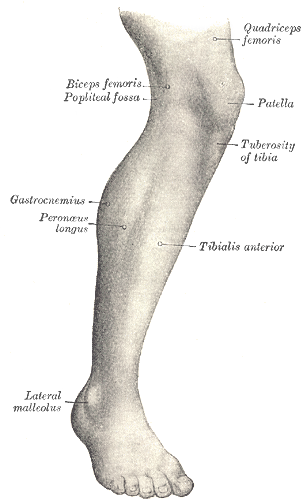Our website is made possible by displaying online advertisements to our visitors.
Please consider supporting us by disabling your ad blocker.
Human leg
| Human leg | |
|---|---|
 Lateral aspect of right leg | |
| Details | |
| Identifiers | |
| Latin | membrum inferius |
| FMA | 7184 |
| Anatomical terminology | |
The leg is the entire lower limb of the human body, including the foot, thigh or sometimes even the hip or buttock region. The major bones of the leg are the femur (thigh bone), tibia (shin bone), and adjacent fibula. There are 60 bones in each leg.
The thigh is located in between the hip and knee. The calf (rear) and shin (front), or shank, are located between the knee and ankle.[1]
Legs are used for standing, many forms of human movement, recreation such as dancing, and constitute a significant portion of a person's mass. Evolution has led to the human leg's development into a mechanism specifically adapted for efficient bipedal gait.[2] While the capacity to walk upright is not unique to humans, other primates can only achieve this for short periods and at a great expenditure of energy.[3] In humans, female legs generally have greater hip anteversion and tibiofemoral angles, while male legs have longer femur and tibial lengths.[4]
In humans, each lower limb is divided into the hip, thigh, knee, leg, ankle and foot.[5] In anatomy, arm refers to the upper arm and leg refers to the lower leg.
- ^ Cite error: The named reference
Muscolino2016was invoked but never defined (see the help page). - ^ Cite error: The named reference
Striedter2016was invoked but never defined (see the help page). - ^ Cite error: The named reference
Hefti2015was invoked but never defined (see the help page). - ^ Shultz SJ, Nguyen AD, Schmitz RJ (2008). "Differences in lower extremity anatomical and postural characteristics in males and females between maturation groups". J Orthop Sports Phys Ther. 38 (3): 137–49. doi:10.2519/jospt.2008.2645. PMID 18383647.
- ^ "Lower limb anatomy".
Previous Page Next Page


